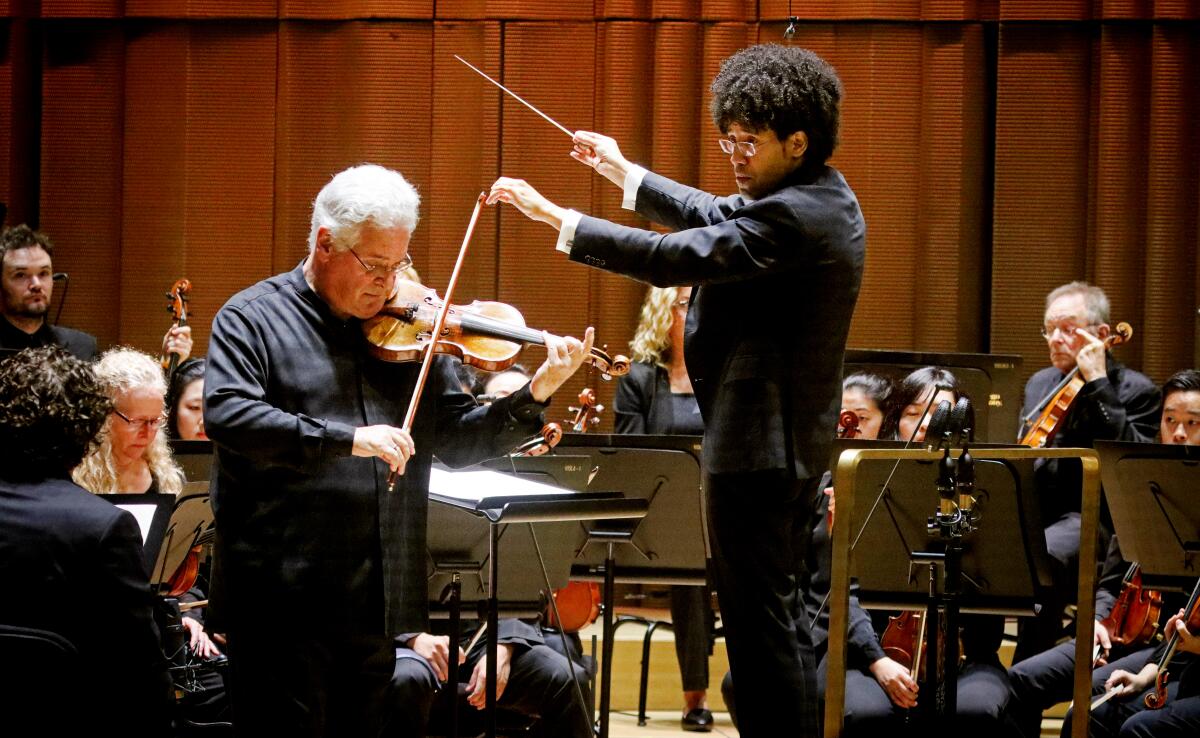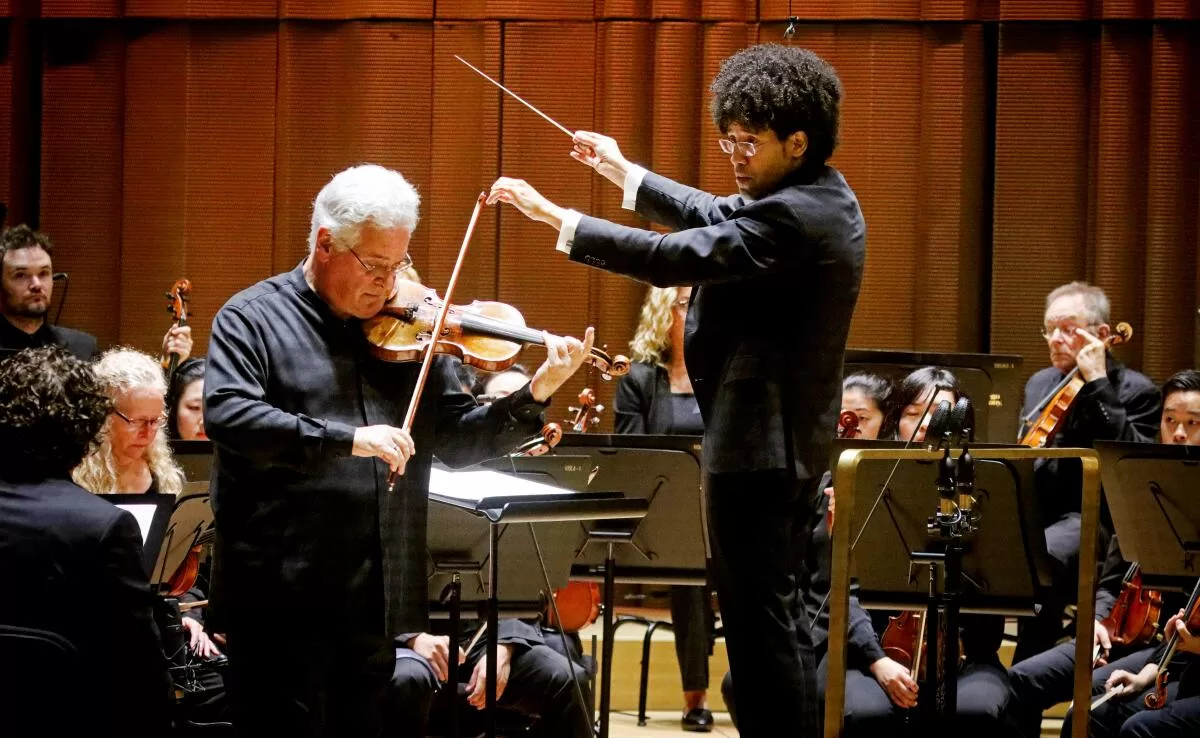There are many reasons for the current rage in renovating concert halls. It is usually cheaper than building something new. The science, as well as the art, of acoustics has advanced. Renovation can be a good way to save a historic hall. But an argument can also be made for simply starting over.
In the case of San Diego Symphony, starting over might have seemed the best option. No American orchestra of San Diego’s merit or promise under its rising star music director, Rafael Payare, had been stuck in so dismaying a venue as Symphony Towers.
Buried in a bland mixed-use skyscraper in the dreary Financial District downtown, an aging, if glamorous, 1929 movie palace with rotten acoustics long served as the San Diego Symphony’s disagreeable home. The first job the orchestra had in giving concerts was to raise your spirits after your having traipsed through a seemingly bureaucratic building in a neighborhood dead at night and on weekends when concerts are given.
But miraculously, the San Diego Symphony has made the dreary become a destination with its renovation by architectural firm HGA and acoustician Paul Scarbrough. The Symphony Towers have turned astonishingly welcoming. The acoustics shine in what had come to be known as Copley Symphony Hall, now named Jacobs Music Center. Even the neighborhood has picked up considerably as the new hall encourages more restaurants to remain open. Parking is easy.
The Jacobs entrance puts you directly in an actual concert hall foyer. The first thing you encounter is a superb artisan bakery where coffee, pastries, sandwiches and the like are half the price and four times the quality of the catering at the Music Center in Los Angeles. Perhaps a few who come to the bakery (which has regular hours) to pick up a loaf of sourdough will be tempted to buy a concert ticket too. The hall is spruced up with new seats and looks lovely.
The one visual downer is the stage, which is no longer wood. It’s covered in what appears to be acoustic material, giving it a cool industrial look that doesn’t reflect colored stage lighting as pleasingly as it does the orchestral sound, which has a combination of warmth and clarity.
Giving the musicians a couple of weeks to settle in (they need, in any new acoustic, a good year or more), I heard the Sunday matinee concluding the second week of regular symphony concerts. Payare’s program, moreover, demonstrated both how the orchestra could come across in a traditional Beethoven concerto as well as in an orchestral showpiece.
The program was to have been Brahms’ Violin Concerto and Schoenberg’s tonally kaleidoscopic, over-the-top early tone poem “Pelleas und Melisande.” Payare recently and spectacularly recorded the latter with the Montreal Symphony, where he also is music director. But when the young violinist Sergey Khachatryan was unable to get his visa approved, a last-minute change was made with the seasoned Pinchas Zukerman in Beethoven’s Violin Concerto.

Violinist Pinchas Zukerman, a late substitute, and music director Rafael Payare performing Beethoven’s Violin Concerto with the San Diego Symphony in Jacobs Music Center.
(Sandy Huffaker / San Diego Symphony)
At 76, the Israeli violinist is more commonly encountered as a conductor, but he made a strong impression at the amplified Hollywood Bowl last summer playing a Mozart concerto with the L.A. Phil led by Zubin Mehta. His tone may not be as strong as it once was, and he needed time to warm up at Jacobs, but he brought a controlled elegance and depth to Beethoven.
From my seat in the balcony there was a refined presence to his tone and a sharp immediacy to every section in the orchestra. When Zukerman returned onstage for an encore, he began by speaking (clearly heard in the hall without a microphone) about the meaning of Brahms’ beloved lullaby.
“I’m hurting,” he said. “The world is upside down. Enough is enough. Bibi!” The only way he knew to calm down an impossible situation, he explained, was to play this lullaby, which he did very softly, with the kind of shocking beauty that only a great artist in an ideally sensitive acoustic could movingly capture.
Schoenberg’s “Pelleas und Melisande” was written 1903 by a 29-year-old composer on the verge of revolutionizing music but still finding his way out of 19th century romanticism. The composer, whose 150th birthday last month is being celebrated this season, employs a huge orchestra for a flamboyant palette of instrumental colors and effects in a vast array of dramatic gestures. A vital storyteller, he thrillingly illustrates Maurice Maeterlinck’s original play, as thoughtfully used surtitles made especially apparent.
So, for his part, did Payare, who has a flare for Schoenberg. He is a conductor of considerable grace and considerable swagger, making the two go unusually yet inexorably together. That meant broad sweeping gestures illuminated tiny details and bursts of wild excitement stayed controlled.
It was a test of not only the orchestra but also the acoustics. Clarity here became the dominant trait. There was neither the glare in high notes that mildly plague the New York Philharmonic’s restored David Geffen Hall, for which Scarbrough also was acoustician, nor quite the richness of Geffen’s base. But Jacobs expertly handles ear-crushing climaxes as well as it does a lullaby. The hall should, over time, open up sonically and, with luck, mellow.
For now, though, it is a place made for excitement. All that’s left is for San Diegans to wake up and smell the coffee on the way in and divine the music inside. On but the second week in the hall, too many of the 1,831 seats were empty.
